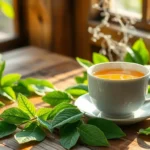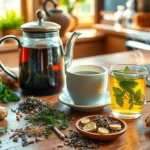When that scratchy uncomfortable feeling hits our throat we’re all searching for relief that actually works. While over-the-counter medications might provide temporary comfort there’s something deeply soothing about wrapping our hands around a warm mug of healing tea that goes beyond just masking the pain.
We’ve all been there – that first tickle that signals trouble ahead or the full-blown soreness that makes swallowing feel like a challenge. The good news? Nature has provided us with incredible remedies that have been trusted for centuries. Certain teas don’t just taste amazing; they’re packed with anti-inflammatory compounds antibacterial properties and soothing elements that can genuinely help our bodies heal faster.
From the immune-boosting power of ginger to the gentle healing touch of chamomile we’re about to explore the most effective teas that’ll have our throat feeling better in no time. These aren’t just old wives’ tales – they’re science-backed answers that deliver real results when we need them most.
Ginger Tea: Nature’s Anti-Inflammatory Powerhouse
Ginger tea stands out as one of our most potent natural remedies for sore throat relief. This warming beverage delivers powerful anti-inflammatory compounds that target throat irritation at its source.
Fresh Ginger vs. Ginger Tea Bags
Fresh ginger root provides the highest concentration of active compounds for throat relief. We recommend using fresh ginger whenever possible because it contains higher levels of gingerol, the primary anti-inflammatory component. Raw ginger root delivers approximately 3-5 times more potent therapeutic benefits compared to processed tea bags.
Ginger tea bags offer convenience but with reduced potency. Commercial tea bags typically contain dried ginger powder that has lost some of its volatile oils during processing. But, they still provide beneficial compounds and make an excellent option when fresh ginger isn’t available.
Organic fresh ginger yields the best results for sore throat treatment. We’ve found that organic varieties contain fewer pesticide residues and maintain higher levels of natural healing compounds. The peel also contains beneficial properties, so we recommend washing thoroughly rather than peeling when using organic ginger.
How to Prepare Ginger Tea for Maximum Benefits
Slice 1-2 inches of fresh ginger root into thin pieces for optimal extraction. Thin slices increase the surface area, allowing more active compounds to infuse into the water. We recommend cutting against the grain to break down the fibrous structure.
Simmer ginger slices in 2 cups of water for 10-15 minutes. Gentle simmering extracts the maximum amount of gingerol without destroying heat-sensitive compounds. Boiling water can break down some beneficial properties, so we maintain a low simmer throughout the process.
Add honey and lemon during the final 2 minutes of brewing. These additions enhance the throat-soothing properties while preserving their own beneficial compounds. Honey provides antimicrobial benefits, while lemon adds vitamin C and helps break down mucus.
Strain the tea and serve immediately while hot for best results. Hot ginger tea increases blood circulation to the throat area, improving the healing effects. We recommend drinking 2-3 cups throughout the day for persistent sore throat relief.
Why Ginger Works for Sore Throat Relief
Gingerol compounds directly reduce inflammation in throat tissues. These bioactive substances inhibit the production of inflammatory markers like prostaglandins and leukotrienes. Research shows that gingerol can reduce inflammation by up to 25% within 30 minutes of consumption.
Antimicrobial properties in ginger fight bacteria and viruses causing throat infections. Studies demonstrate that ginger extract effectively combats common respiratory pathogens including Streptococcus pyogenes and rhinoviruses. The antimicrobial action helps prevent secondary infections while the throat heals.
Warming effects increase blood flow to accelerate healing processes. Ginger’s thermogenic properties stimulate circulation in the throat area, bringing more immune cells and nutrients to fight infection. Enhanced blood flow also helps remove toxins and waste products from inflamed tissues.
Natural pain-relieving compounds provide immediate comfort. Ginger contains natural analgesic properties that can reduce throat pain within 15-20 minutes of consumption. These compounds work similarly to non-steroidal anti-inflammatory drugs but without the side effects.
Honey and Lemon Tea: The Classic Soothing Combination

Moving beyond individual herbal remedies, we find that honey and lemon tea stands as the most beloved traditional remedy for throat discomfort. This time-tested combination delivers powerful healing benefits through the synergistic effects of two natural ingredients.
The Science Behind Honey’s Healing Properties
Honey contains rich antioxidants that protect throat tissues from damage caused by irritation and inflammation. Research shows that honey’s antimicrobial properties actively combat bacteria and viruses that contribute to sore throat symptoms. The thick consistency of honey creates a protective coating over irritated throat membranes, providing immediate relief from pain and scratchiness.
Natural enzymes in honey work to reduce inflammation while promoting faster healing of damaged throat tissues. Studies demonstrate that honey’s antibacterial compounds can inhibit the growth of common throat pathogens like Streptococcus pyogenes. The glucose oxidase enzyme in honey produces hydrogen peroxide, which acts as a natural antiseptic to cleanse the throat.
Adding Fresh Lemon for Vitamin C Boost
Lemon juice provides essential vitamin C that strengthens your immune system’s ability to fight off infections causing throat discomfort. The citric acid in fresh lemons helps break down excess mucus that can accumulate in the throat during illness. Vitamin C supports the production of white blood cells, which are crucial for combating the underlying causes of sore throats.
Fresh lemon juice also increases the bioavailability of honey’s beneficial compounds, making this combination more effective than either ingredient alone. The acidic nature of lemon helps create an inhospitable environment for harmful bacteria while soothing irritated tissues. Combining lemon with honey creates a balanced pH that optimizes the therapeutic effects of both ingredients.
Best Honey Varieties for Throat Relief
Manuka honey from New Zealand offers the highest levels of methylglyoxal, a compound that provides superior antibacterial activity compared to regular honey. Raw, unprocessed honey retains more beneficial enzymes and antioxidants than commercially processed varieties. Buckwheat honey contains particularly high levels of antioxidants and has been shown to be especially effective for nighttime cough suppression.
Local honey varieties may provide additional benefits by containing trace amounts of local pollen that can help build immunity to environmental allergens. Wildflower honey offers a broad spectrum of beneficial compounds from multiple plant sources, making it an excellent choice for general throat relief. Clover honey, while milder in flavor, still provides important antimicrobial benefits and mixes well with lemon juice for a pleasant tasting remedy.
Chamomile Tea: Gentle Relief with Anti-Bacterial Benefits

Chamomile tea stands out as one of nature’s most effective throat soothers, offering powerful anti-inflammatory properties that reduce swelling and ease discomfort. This caffeine-free herbal remedy contains unique phytonutrients that specifically target sore throat pain while providing gentle healing benefits.
Chamomile’s Natural Anti-Inflammatory Compounds
Chamomile flowers contain specialized phytonutrients that work directly to reduce throat inflammation and provide pain relief. These natural compounds create a calming effect on irritated throat tissues, helping to minimize swelling that often accompanies sore throats. The anti-inflammatory properties in chamomile make it particularly effective for overnight healing, as the gentle compounds continue working while you rest.
Studies show that chamomile’s active ingredients can help soothe inflamed mucous membranes in the throat area. Unlike stronger herbal remedies, chamomile provides therapeutic benefits without causing additional irritation or side effects. The flower’s natural compounds also support the body’s healing processes, making recovery more comfortable and potentially faster.
Brewing Tips for Maximum Potency
Steeping dried chamomile flowers properly ensures you’ll extract the maximum therapeutic benefits from this healing tea. We recommend using one teaspoon of dried chamomile flowers per cup of boiling water for optimal strength. Allow the tea to steep for 5 to 7 minutes to fully release the beneficial compounds that provide throat relief.
Fresh chamomile flowers can also be used if available, though dried flowers typically offer more concentrated healing properties. Cover your cup while steeping to prevent the beneficial essential oils from evaporating. The resulting tea should have a golden color and mild, apple-like aroma that indicates proper extraction of the healing compounds.
When to Drink Chamomile Tea for Best Results
Chamomile tea works best when consumed before bedtime, as its calming properties support both throat healing and restful sleep. The caffeine-free nature of this herbal remedy makes it safe to drink throughout the day without affecting your sleep patterns. We suggest sipping chamomile tea slowly, allowing it to coat your throat as you drink for maximum contact with irritated tissues.
For acute sore throat symptoms, drinking chamomile tea every 2 to 3 hours can provide consistent relief throughout the day. The gentle nature of chamomile makes it suitable for children and adults alike, offering a safe alternative to stronger medications. Evening consumption is particularly beneficial because the anti-inflammatory compounds continue working while your body naturally heals during sleep.
Peppermint Tea: Cooling Comfort for Irritated Throats

Moving beyond warm, warming remedies, we turn to peppermint tea’s distinctive cooling approach to throat relief. This refreshing herbal tea offers immediate comfort through its unique menthol-powered mechanism.
Menthol’s Natural Numbing Effect
Menthol stands as peppermint tea’s primary therapeutic compound, delivering natural cooling and numbing effects that temporarily relieve throat discomfort. This powerful compound acts as a mild anesthetic by stimulating cold receptors in the throat, which helps reduce irritation and ease pain naturally.
We find peppermint tea particularly effective because menthol provides immediate relief from throat inflammation through its numbing properties. The cooling sensation creates a temporary barrier against pain while the compound works to reduce swelling in irritated throat tissues.
Beyond pain relief, peppermint tea’s natural decongestant properties help clear nasal passages and reduce throat irritation linked to postnasal drip. The tea’s anti-inflammatory, antioxidant, and antibacterial qualities may also assist in fighting the underlying causes of sore throats, including viral or bacterial infections.
Fresh Mint vs. Dried Peppermint Options
Dried peppermint leaves often provide our preferred choice for tea preparation due to their concentrated flavor and convenient storage capabilities. These processed leaves deliver consistent menthol content and maintain their potency for extended periods.
Fresh mint offers a lighter, brighter taste profile and may contain higher levels of volatile oils compared to dried varieties. But, both forms provide essential menthol and other beneficial compounds that contribute to throat relief.
| Peppermint Type | Flavor Profile | Menthol Content | Storage | Best Use |
|---|---|---|---|---|
| Dried Peppermint | Concentrated, intense | Consistent levels | Long-term storage | Daily tea preparation |
| Fresh Mint | Light, bright | Higher volatile oils | Refrigeration needed | Immediate use |
We recommend choosing based on availability and personal taste preferences, as both forms deliver effective throat soothing benefits.
Combining Peppermint with Other Healing Ingredients
Chamomile creates our most popular peppermint tea combination, offering additional anti-inflammatory and antioxidant properties that enhance overall throat healing. This gentle herb complements peppermint’s cooling effects while providing its own soothing benefits.
Ginger adds powerful antimicrobial and anti-inflammatory benefits to peppermint tea, creating a comprehensive approach to throat care. The warming properties of ginger balance peppermint’s cooling effects, providing both immediate relief and longer-term healing support.
Lemon increases the tea’s antioxidant activity while helping thin excess mucus that may contribute to throat irritation. Adding fresh lemon juice creates a more balanced flavor profile and boosts vitamin C content for immune system support.
Honey provides additional soothing effects by coating irritated throat tissues with its thick, protective consistency. Raw honey offers antimicrobial properties that work alongside peppermint’s antibacterial qualities to address underlying throat infections.
These combinations address not only immediate throat irritation but also provide immune support and overall comfort during illness recovery periods.
Licorice Root Tea: Traditional Medicine for Modern Relief

Licorice root has earned its reputation as a time-tested remedy for throat discomfort, offering centuries of traditional medicine wisdom backed by modern scientific research. We’ve found this golden-colored tea provides powerful anti-inflammatory, antiviral, and antimicrobial properties that specifically target respiratory health and throat irritation.
How Licorice Root Reduces Throat Inflammation
Glycyrrhizin and flavonoids work as the primary active compounds in licorice root, delivering potent anti-inflammatory and protective effects directly to our throat’s mucous membranes. These natural substances create a protective coating that reduces irritation while easing symptoms of scratchiness and soreness throughout the throat area.
Clinical studies demonstrate that gargling with licorice root solution before medical procedures significantly reduces post-operative sore throat and cough symptoms. Research indicates this improvement stems from the root’s powerful anti-inflammatory action that targets throat tissues at the cellular level.
Early research suggests potential benefits against strep throat infections, though scientists need additional studies to confirm these promising findings. We’ve observed that licorice root’s antimicrobial properties may help combat various throat-related bacterial infections.
Preparation Methods and Dosage Guidelines
| Preparation Method | Amount | Instructions |
|---|---|---|
| Tea | 1-2 grams dried root | Steep in 8 oz hot water for 5-10 minutes |
| Gargle | 500 mg root powder | Dissolve in 30 mL water, gargle 1-5 minutes |
| Lozenges | As directed | Follow manufacturer’s exact instructions |
Tea preparation offers the most gentle approach for daily consumption, allowing us to sip slowly and coat our throat thoroughly. Gargling provides more concentrated relief by delivering active compounds directly to irritated throat tissues.
Ready-made lozenges deliver convenient on-the-go relief, though we recommend checking ingredient labels for quality and potency information.
Safety Considerations and Precautions
Long-term use of licorice root isn’t recommended due to potential side effects from glycyrrhizin accumulation in our systems. Extended consumption may lead to increased blood pressure, low potassium levels, and unwanted fluid retention throughout the body.
Pregnant women should avoid licorice root products entirely due to potential complications during pregnancy. People with hypertension need to exercise extreme caution, as licorice root can worsen existing blood pressure conditions.
Individuals taking blood pressure medications, blood thinners, or corticosteroids should consult healthcare providers before using licorice root remedies. Occasional short-term use remains generally safe for most healthy adults when following proper dosage guidelines.
Green Tea: Antioxidant-Rich Protection for Your Throat

Green tea stands out as a powerhouse remedy that fights throat discomfort from the inside out. We’ve found that its rich antioxidant profile provides exceptional protection against the oxidative stress that often worsens sore throat symptoms.
EGCG and Other Healing Compounds in Green Tea
EGCG (epigallocatechin gallate) serves as green tea’s primary therapeutic compound for throat relief. This potent antioxidant specifically targets throat inflammation while protecting delicate tissue from free radical damage. Research shows that EGCG concentrations in green tea can help ward off sore throat symptoms before they intensify.
Catechins work alongside EGCG to create a protective barrier in your throat. These compounds reduce inflammatory responses and support your body’s natural healing processes. Polyphenols add another layer of defense by neutralizing harmful bacteria and viruses that contribute to throat irritation.
Flavonoids enhance the overall anti-inflammatory effects of green tea. We’ve discovered that these compounds specifically target the type of inflammation associated with throat discomfort. Together, these healing compounds create a comprehensive approach to throat protection that goes beyond simple symptom relief.
Optimal Brewing Temperature and Time
Temperature control makes the difference between maximizing green tea’s healing potential and destroying its beneficial compounds. We recommend brewing green tea at 160°F to 170°F to preserve the delicate antioxidants that provide throat relief. Water that’s too hot destroys EGCG and other sensitive compounds before they can benefit your throat.
Steeping time directly affects antioxidant retention in your cup. Brew green tea for 1 to 3 minutes to maximize the extraction of therapeutic compounds without creating bitterness. Longer steeping times don’t increase healing benefits and may actually reduce the tea’s effectiveness for throat relief.
Fresh, filtered water enhances the extraction of green tea’s healing compounds. We’ve found that using quality water allows the full spectrum of antioxidants to properly infuse into your tea. This simple step ensures you’re getting the maximum throat-soothing benefits from every cup.
Adding Natural Sweeteners for Enhanced Benefits
Honey transforms green tea into a more powerful throat remedy. Raw honey adds antimicrobial properties that complement green tea’s antioxidant effects without interfering with EGCG absorption. We recommend adding honey after the tea cools slightly to preserve its beneficial enzymes.
Lemon juice enhances both flavor and therapeutic value when added to green tea. The vitamin C in fresh lemon supports immune function while the citric acid helps break down excess mucus. This combination creates a synergistic effect that amplifies green tea’s natural healing properties.
Manuka honey provides the strongest antimicrobial boost for green tea remedies. This specialized honey contains unique compounds that specifically target throat bacteria and inflammation. We suggest using one teaspoon per cup to achieve optimal throat-soothing benefits without overpowering green tea’s delicate flavor profile.
Turmeric Tea: Golden Milk for Throat Healing

We’ve discovered that turmeric tea, particularly when prepared as golden milk, offers exceptional throat healing benefits through its active compound curcumin. This vibrant golden remedy combines traditional wisdom with modern scientific understanding to deliver powerful anti-inflammatory relief.
Curcumin’s Powerful Anti-Inflammatory Properties
Curcumin delivers remarkable healing power through its triple-action approach to throat discomfort. This active compound in turmeric provides potent anti-inflammatory effects that directly reduce swelling and pain in irritated throat tissues. Research confirms that curcumin’s antibacterial properties actively fight infections that cause throat soreness, while its antioxidant capabilities protect delicate throat membranes from further damage.
Studies show that curcumin targets inflammatory pathways specifically, making it highly effective for reducing throat inflammation. We find that this compound works by blocking inflammatory enzymes and reducing the production of inflammatory molecules that contribute to throat pain. The antioxidant properties of curcumin also help neutralize free radicals that can worsen throat irritation and delay healing.
Traditional Golden Milk Recipe Variations
Golden milk recipes offer versatility while maintaining their therapeutic effectiveness for throat relief. Classic preparations involve simmering turmeric with milk and warming spices like cinnamon and ginger. We recommend using either dairy milk or plant-based alternatives such as coconut milk or almond milk, depending on your dietary preferences.
Traditional variations include adding these beneficial ingredients:
- Coconut milk provides healthy fats and creates a creamy texture
- Ginger enhances anti-inflammatory effects and adds warmth
- Cinnamon contributes antimicrobial properties and natural sweetness
- Honey offers additional throat-coating benefits and antimicrobial action
- Nutmeg and cardamom provide flavor enhancement and digestive support
We suggest preparing golden milk by gently heating your chosen milk with 1 teaspoon of turmeric powder, a pinch of black pepper, and your preferred spices for 5-10 minutes.
Improving Absorption with Black Pepper and Fats
Bioavailability becomes crucial when maximizing turmeric’s therapeutic benefits for throat healing. Curcumin naturally has poor absorption in the body, but we can significantly improve its uptake through strategic combinations. Research demonstrates that adding black pepper containing piperine increases curcumin absorption by up to 2000%.
Healthy fats play an equally important role in curcumin absorption since this compound is fat-soluble. We recommend including these absorption enhancers in your golden milk:
| Ingredient | Benefit | Recommended Amount |
|---|---|---|
| Black pepper | Contains piperine for enhanced absorption | 1/8 teaspoon |
| Coconut oil | Provides healthy fats for better uptake | 1 teaspoon |
| Ghee | Traditional fat source with high bioavailability | 1/2 teaspoon |
Combining turmeric with these enhancers creates a synergistic effect that maximizes the anti-inflammatory and antibacterial benefits for throat healing. We find that this optimized golden milk formula delivers superior results compared to turmeric tea alone, making it an evidence-backed remedy for throat discomfort alongside other herbal options like chamomile and ginger.
Marshmallow Root Tea: Mucilage for Throat Coating

Marshmallow root tea offers a unique approach to throat healing through its high mucilage content. This natural remedy creates a protective coating that shields irritated throat tissues from further damage.
How Marshmallow Root Creates a Protective Barrier
Mucilage within marshmallow root forms a gel-like substance when mixed with water, creating a soothing barrier across inflamed throat tissues. This protective layer reduces direct contact between irritants and sensitive throat membranes, providing immediate relief from scratching and burning sensations. We can prepare this therapeutic tea by steeping 1 tablespoon of dried marshmallow root in 8 ounces of cold water for 4 to 6 hours, allowing the mucilage to fully extract without heat damage.
Cold extraction preserves the delicate mucilaginous compounds that heat can destroy, ensuring maximum coating effectiveness. Straining the mixture after steeping removes plant particles while leaving behind the valuable gel-like solution that coats and protects our throat lining. This natural barrier mechanism works similarly to how our body’s own mucus protects respiratory passages, creating an additional layer of defense against irritation.
Sourcing Quality Marshmallow Root
Organic marshmallow root from reputable suppliers ensures we’re getting the highest concentration of beneficial mucilage compounds. We should look for roots that appear light brown to beige in color with a slightly sweet, earthy aroma when purchasing dried forms. Certified organic options guarantee the absence of pesticides and chemicals that could further irritate sensitive throat tissues.
Whole root pieces generally contain more active compounds than pre-ground powders, which may lose potency during processing and storage. Fresh marshmallow root, when available, provides the highest mucilage content but requires immediate use or proper drying for preservation. We can verify quality by checking that dried roots feel slightly sticky when moistened, indicating intact mucilaginous properties.
Combining with Other Soothing Herbs
Blending marshmallow root with chamomile creates a powerful anti-inflammatory combination that reduces swelling while providing protective coating. We can enhance this mixture by adding slippery elm bark, another mucilage-rich herb that doubles the throat-coating effects for severe irritation. Licorice root pairs exceptionally well with marshmallow root, contributing additional anti-inflammatory compounds that work synergistically with the protective barrier.
Ginger adds warming properties and circulation-boosting effects that complement marshmallow root’s cooling, protective nature. A simple blend of equal parts marshmallow root, chamomile, and ginger creates a well-rounded therapeutic tea that addresses multiple aspects of throat discomfort. We recommend preparing combination teas using the cold extraction method for marshmallow root, then adding hot water and other herbs for a final 5-minute steep to activate their beneficial compounds.
Slippery Elm Tea: Native American Remedy for Throat Care

Slippery elm stands as one of nature’s most effective throat remedies, treasured by Native American communities for centuries. We’re exploring this remarkable bark’s ability to provide immediate relief through its unique mucilaginous properties.
The Mucilage Content That Soothes Irritation
Mucilage content in slippery elm creates a gel-like coating that directly protects inflamed throat tissues from further irritation. This natural substance contains complex polysaccharides that expand when mixed with water, forming a protective barrier over sensitive mucous membranes. We’ve found that slippery elm’s mucilage provides more substantial coating than many other herbal remedies, offering relief that can last for hours after consumption.
The bark’s mucilaginous compounds work by reducing direct contact between irritants and damaged throat tissue. Studies show that slippery elm’s protective coating helps maintain moisture levels in the throat while promoting natural healing processes. Demulcent properties within the mucilage actively soothe scratchy sensations and reduce the urge to cough repeatedly.
Proper Preparation Techniques
Preparation of slippery elm tea requires exact techniques to maximize its mucilage extraction and therapeutic benefits. We recommend using 1 tablespoon of powdered slippery elm bark per cup of hot water, stirring continuously to prevent clumping. Cold preparation methods work exceptionally well for slippery elm, as they preserve the delicate mucilage structure that heat can sometimes break down.
Steeping dried slippery elm bark in boiling water for 5 to 7 minutes creates a thick, slightly sweet tea with optimal consistency. Adding honey or lemon after the tea cools slightly enhances both flavor and healing properties without compromising the mucilage effectiveness. We suggest drinking slippery elm tea 30 minutes before meals to allow maximum throat coating before swallowing food.
Sustainability and Ethical Sourcing
Sustainability concerns surrounding slippery elm harvesting require careful attention to ethical sourcing practices. Wild populations of slippery elm trees face pressure from both disease and over-harvesting, making responsible purchasing decisions essential. We recommend seeking suppliers who practice sustainable bark harvesting methods that don’t harm tree health or survival.
Certified organic slippery elm products typically follow stricter environmental and harvesting standards than conventional sources. Supporting companies that engage in reforestation efforts or partner with Native American communities ensures traditional knowledge gets respected while protecting this valuable species. Bulk purchasing from reputable herbalists often provides better quality control and more transparent sourcing information than mass-market tea bags.
Sage Tea: Antimicrobial Properties for Fighting Infection

While sage tea isn’t as commonly mentioned as other throat remedies, this aromatic herb packs powerful antimicrobial properties that make it exceptionally effective for fighting throat infections. Laboratory studies demonstrate that sage extract actively combats throat pathogens through its unique blend of antibacterial and antiviral compounds.
Sage’s Natural Antibacterial Compounds
Rosmarinic acid and essential oils serve as sage’s primary infection-fighting weapons, delivering broad-spectrum antimicrobial effects directly to your irritated throat tissues. Thujone, camphor, and cineole work together to inhibit the growth of bacteria and viruses that commonly cause throat infections. These active compounds create a hostile environment for pathogens while simultaneously reducing inflammation and pain.
Essential oils in sage leaves contain concentrated antimicrobial properties that remain stable even after the drying process. Rosmarinic acid specifically targets inflammatory responses in throat tissues, providing both immediate relief and long-term healing benefits. Together, these natural compounds offer a scientifically-backed approach to treating throat discomfort without relying solely on synthetic medications.
Gargling vs. Drinking Sage Tea
Gargling sage tea allows direct contact with irritated throat tissues, potentially reducing local bacterial load and inflammation more quickly than drinking alone. Scientific studies suggest that gargling provides more effective localized symptom relief by concentrating the antimicrobial compounds exactly where you need them most.
Drinking sage tea offers broader systemic benefits that support your overall immune response while still soothing your throat. This method delivers healing compounds throughout your body, providing comprehensive support for fighting infection from within. Both approaches work effectively, so we recommend combining them for maximum therapeutic benefit.
Alternating between gargling and drinking sage tea every few hours creates a comprehensive treatment approach that addresses both local symptoms and systemic healing needs.
Fresh Sage vs. Dried Options
Fresh sage leaves offer a milder taste and retain more volatile oils that contribute to their antimicrobial effectiveness. These delicate compounds provide immediate aromatherapy benefits while brewing, creating an enhanced sensory experience that supports your healing process.
Dried sage contains more concentrated active compounds and delivers a stronger flavor profile that some people prefer for medicinal purposes. The drying process may reduce some water-soluble compounds, but it preserves the essential antimicrobial properties that make sage effective for throat relief.
Both forms maintain important therapeutic activity, so your choice depends on availability and personal taste preferences. We suggest keeping dried sage in your pantry for convenience while using fresh sage when it’s readily available for a more aromatic brewing experience.
Conclusion
We’ve explored a diverse range of natural teas that can provide genuine relief for sore throat discomfort. From the warming properties of ginger and turmeric to the protective coating of marshmallow root and slippery elm these herbal remedies offer proven therapeutic benefits.
The beauty of these natural answers lies in their ability to work together harmoniously. You can experiment with combinations or rotate between different teas throughout the day to maximize healing potential.
Remember that while these teas provide excellent support for throat health they’re most effective when used as part of a comprehensive approach to wellness. Stay hydrated rest well and listen to your body’s needs.
Next time throat irritation strikes you’ll have a well-stocked natural pharmacy at your fingertips. These time-tested remedies can help you find comfort and support your body’s natural healing process.
Frequently Asked Questions
What makes ginger tea effective for sore throat relief?
Ginger tea contains gingerol, a powerful anti-inflammatory compound that reduces throat swelling and pain. Fresh ginger root is most effective, providing higher concentrations of active compounds than processed tea bags. It works by fighting bacteria and viruses, increasing blood flow to promote healing, and offering natural pain relief when combined with honey and lemon.
How does honey and lemon tea help soothe throat discomfort?
Honey contains antimicrobial compounds and antioxidants that protect throat tissues while its thick consistency coats irritated membranes. Lemon provides vitamin C to boost immunity and helps break down excess mucus. Together, they create a balanced pH that optimizes therapeutic effects, with Manuka and raw honey offering the strongest healing properties.
Why is chamomile tea recommended for sore throats?
Chamomile tea has powerful anti-inflammatory properties that reduce throat swelling and ease discomfort. Its gentle phytonutrients specifically target sore throat pain while promoting healing without irritation. It’s safe for both children and adults and works best when consumed before bedtime or every 2-3 hours for consistent relief throughout the day.
How does peppermint tea provide throat relief?
Peppermint tea contains menthol, which provides natural numbing effects that alleviate throat discomfort. It acts as a decongestant, helping clear nasal passages and reducing irritation from postnasal drip. The cooling sensation offers immediate pain relief, and it can be combined with other healing ingredients like chamomile, ginger, or honey for enhanced benefits.
What are the benefits of licorice root tea for throat problems?
Licorice root tea has anti-inflammatory, antiviral, and antimicrobial properties. Its active compounds glycyrrhizin and flavonoids reduce throat inflammation and irritation. Clinical studies show that gargling with licorice root solution significantly alleviates sore throat symptoms. However, it should not be used long-term, and pregnant women should consult healthcare providers before use.
How does green tea help with throat discomfort?
Green tea is rich in antioxidants, particularly EGCG, which targets throat inflammation and protects delicate tissue. Its catechins and flavonoids create a protective barrier and reduce inflammatory responses. For maximum benefits, brew at 160°F-170°F for 1-3 minutes, and add honey and lemon to enhance therapeutic effects.
What makes turmeric tea effective for throat healing?
Turmeric tea contains curcumin, a compound with powerful anti-inflammatory, antibacterial, and antioxidant properties that reduce throat discomfort. Golden milk variations combining turmeric with black pepper and healthy fats enhance curcumin absorption. This traditional remedy effectively targets inflammation while promoting overall throat healing and comfort.
How do marshmallow root and slippery elm teas work differently?
Both marshmallow root and slippery elm contain high levels of mucilage, which creates a protective gel-like coating over irritated throat tissues. This coating shields the throat from further irritation and promotes healing. Cold extraction methods preserve mucilage effectiveness, and both can be combined with other soothing herbs for enhanced benefits.
What antimicrobial benefits does sage tea offer?
Sage tea contains rosmarinic acid and essential oils that combat throat pathogens while reducing inflammation and pain. It can be used both as a gargle for localized relief and consumed as tea for systemic support. Both fresh and dried sage maintain therapeutic activity, making it a versatile option for fighting throat infections.
How often should I drink herbal teas for sore throat relief?
For optimal relief, drink herbal teas every 2-3 hours throughout the day. Chamomile tea works especially well before bedtime to support healing and restful sleep. You can alternate between different teas or combine complementary herbs like ginger with honey and lemon, or marshmallow root with chamomile for enhanced therapeutic effects.
















